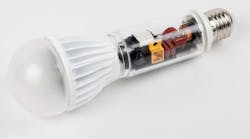Despite their advantages as light sources—they consume less energy, use no harmful substances, and last up to 30,000 hours—LEDs are extremely sensitive to variations and spikes in power. They need a driver that ensures a constant supply of power at all times to function properly. These drivers then must take the alternating current from the grid and convert it into direct current with a reduced voltage, so they must face a lot of demands of their own.
Related Articles
- LEDs Line Up To Replace Residential Incandescent Bulbs
- Use A Flyback Topology To Drive Custom LED Lighting
- What's All This About Van Gogh And LEDs?
Researchers at the Fraunhofer Institute for Applied Solid State Physics IAF in Freiburg, Germany, are turning to voltage transformers that feature gallium-nitride (GaN) transistors for the kind of robust construction that can stand up to these demands (see the figure). GaN components can operate at higher currents, voltages, and temperatures than standard silicon transistors. They also can switch at high frequencies, which has a significant impact on the size of the coils and condensers built into the drivers for energy storage.
In a GaN-based driver, the switch speed can be made as much as 10 times faster than its silicon equivalents. The researchers believe that, applied to a smaller surface, switching can be cheaper. The LED lamp also can be lighter and more compact while delivering the same or improved illumination, they note. The energy storage component plays a decisive role in manufacturing costs, which could have an extremely positive effect on the end price.
The researchers have improved the GaN driver’s efficiency to 86%, which they say is between one and four percentage points better than its silicon equivalent. Compared to the silicon transistor LED lamps now on the market, the researchers also were able to increase the light output. While the luminous flux of commercial LED retrofit lamps featuring silicon components is around 1000 lumen, IAF researchers have achieved 2090 lumen.
“One shouldn’t underestimate the role played by the efficiency of LED drivers,” said Michael Kunzer, group manager at Fraunhofer IAF, noting that 20% of the world’s energy consumption can be attributed to lighting. “In principle, the higher the light yield and efficiency, the lower energy consumption is. If you think that by 2020 LEDs will have carved out a market share of almost 90%, then it is obvious that they will play a significant role in protecting our environment.”
